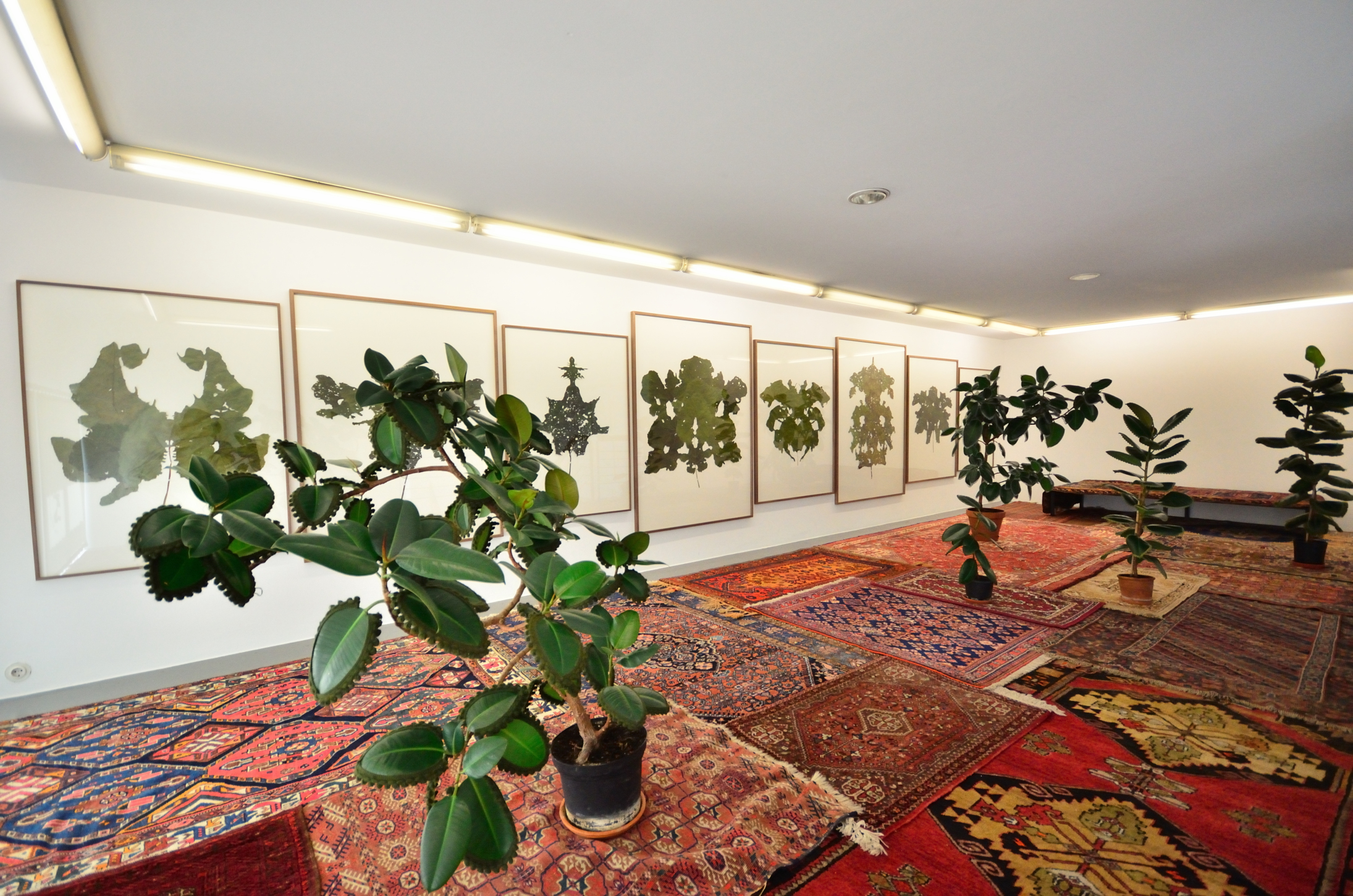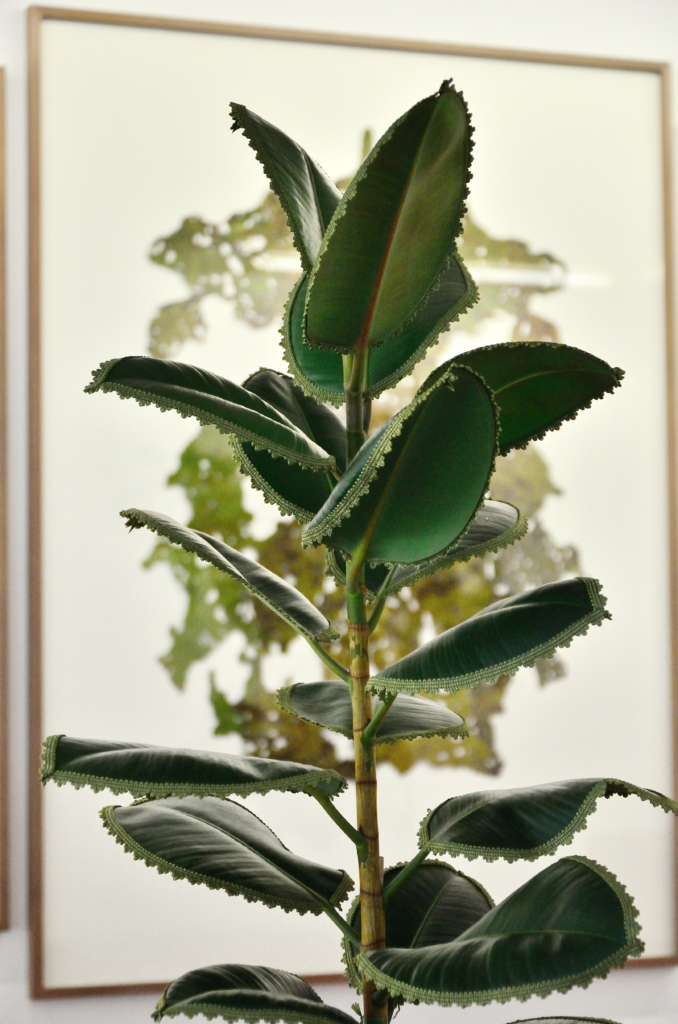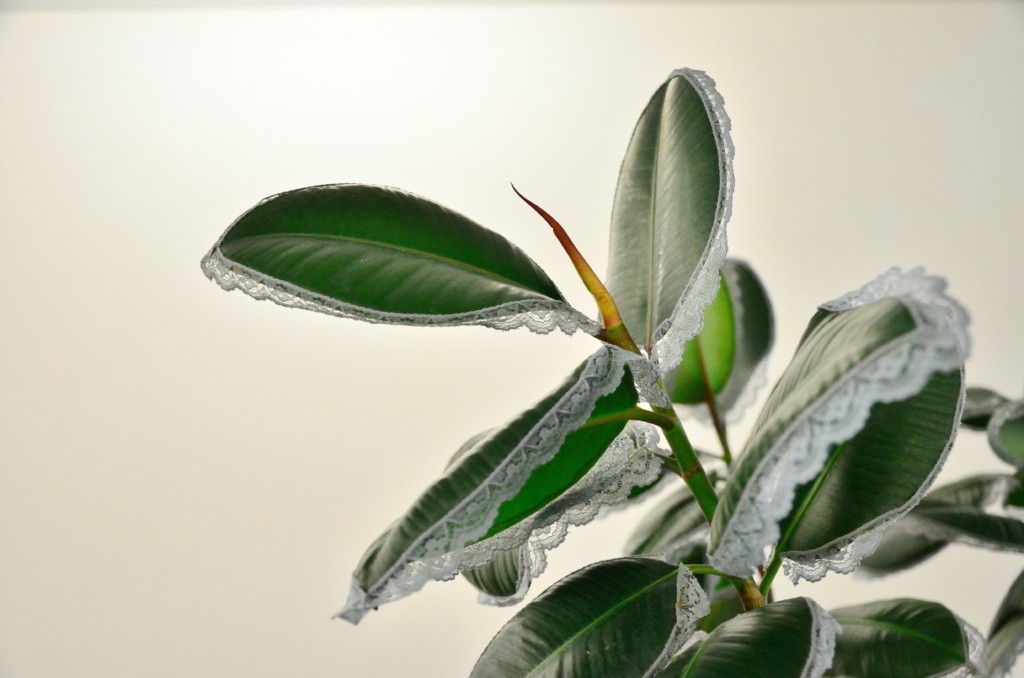Regula Dettwiler
It’s my Nature
Where Regula Dettwiler takes the reins, plants determine the setting. In keeping with the title of our exhibition, one could say, “It’s her nature,” or, “That’s just the way the artist is.” But this title can also be understood in another way, because at its core it contains the very essence of her art: in fact, the plant-based images and installations are nothing less than Dettwiler’s (!) nature, one created by her – and that is her art!
If we understand the history of nature and the naming of its flora and fauna as a human attempt to organize, comprehend, define, and thus control the “chaos” of nature, then the question arises as to whether everything we perceive as ‘nature’ already appears as a projection or construction according to our ideas of a “natural” world.
Dettwiler confronts us with an entire wall of such “constructions” in her extremely decorative watercolors of exotic flowers and plants. What we see is an extremely detailed depiction of plant components, which suggests not only an excellent mastery of artistic craftsmanship, but also an almost scientific observation. On closer inspection, we see, for example, that the fleshy leaves on the stem of the orchid are not only detached, but also wired and held together with a textile band. Among the flower parts lined up to the right and left of it, there is also an indication that there are 3x and 6x pistils and petals, respectively. In these depictions, Dettwiler imitates a method used by 18th-century naturalists by creating a collection of artificial orchids, as if she were a botanist, taking them apart, and then meticulously capturing and defining them in watercolors. Each sheet contains relevant information about the species of the plant, its origin, and where it was found. These seemingly innocuous notes are significant because they provide insight into Dettwiler’s artistic practice.
In order to locate artificial orchids, the artist goes on a veritable hunt. She roams the shopping malls of the world—in Rome, London, Chicago, Las Vegas, Tokyo, New York, and Montreal. The exotic orchid made of fabric and plastic can be found everywhere and thus becomes a pars pro toto of an industrialized society’s standardized understanding of nature, in which plants typical of a country and regional characteristics are displaced. (Even the cyclamen is produced in China and distributed worldwide.) By taking these replicas apart and defoliating them, the artist purports to reveal the structure of the plant. In fact, however, she dismantles them into the components that were manufactured for production reasons in order to be able to produce these flowers industrially, preferably in China, Taiwan, and Korea. These are construction drawings of a “nature” that can only be found as a representation. At the same time, when viewing her fascinating and beautiful watercolors, a certain unease becomes apparent—in the sober realization that the artist is confronting us with an eerie fact: nature has given way to lifelike replicas that are treated with the same artistic attention as living plants once were.
But in this exhibition, we also encounter real plants, which inhabit a kind of psycho-space on the gallery above. It is not easy to describe in words a space in which images, plant forms, and ornaments simultaneously intrude on our consciousness. At first glance, it is a very comfortable space, lavishly laid out with richly patterned Persian carpets, inviting us to linger. But anyone who sits down on the couch is overcome by a certain uneasiness in view of the plant-based Rorschach images, which are quite capable of bringing the unconscious to light with their associations. So it is not the decorative plant world that we encounter here, but a kind of hybrid of organic phenomena – a cross between plant and insect, the likes of which could not be found more beautifully in a Renaissance cabinet of curiosities.
And then there are the rubber trees, whose leaves are decorated with different borders that seem to grow out of them, as it were. We encounter Rüdiger, the friendly rubber tree from next door, the nice one of the easy-care variety – a kind of good buddy, whom Dettwiler has equipped with pom-pom-like leaf edges. Or Sigmund with green fringes, who has something of an eco-activist about him, and a somewhat capricious Albert, whose leaves are framed by gray lace.
Dettwiler describes them as portraits, meaning that her stylized houseplants become projections—just as nature in general becomes a projection of human sensibilities and needs. Or, as the writer Heinrich Steinfest puts it, “Potted plants that live close to humans become similar to them over time: enthusiastic, baroque, melancholic, exuberant, talkative, suicidal. Potted plants have no opinions and can therefore be manipulated in any direction…” They confront us with the question of where the boundaries between nature and art lie and whether such distinctions can still be made in our world.
To further heighten this sense of uncertainty, we are surrounded by eerie images that Dettwiler has cut out of herbarium leaves. She refers to them as “Rorschach images,” alluding to the inkblot images of the same name used in psychodiagnostic testing. When viewed from a distance, Dettwiler’s Rorschach paper cutouts really do look confusingly similar to inkblot images: their symmetry and associative forms look as if the artist had actually let ink run on a sheet of paper to create nightmarish grimaces and grotesque studies of butterflies and insects. But on closer inspection, her “blots” reveal themselves to be pressed leaves from native trees and shrubs—greenish-brown with veins and stems. The edges of the leaves are frayed or partially jagged and cut, creating an irregular outline that triggers a variety of associations.
So we encounter images that we think we recognize, only to discover that they are constructed images created through cropping, collage techniques, and other manipulations. The associative diversity already present in Rorschach inkblot images is reinforced by the structure of the leaves, which suggest organic forms such as bat wings, branches, insect legs, etc., with the skin-like surface and fragility of the dried leaves playing an important role. But unlike the inkblot images of the Rorschach tests, Dettwiler’s images seem more like objects. After all, they are herbarium plants and not paintings or drawings. Here, “nature” is no longer the object of contemplation, but the tool for an art that aims to create a certain “nature” of its own.
This position is no coincidence and reflects a development that, at the latest with the breakthrough of genetic engineering, cannot remain without consequences in art either: we must assume that nature that has not already been defined and manipulated by humans, and thus precedes culture, now only exists to a limited extent. Natural events, natural disasters, and weather phenomena are just as influenced by human intervention as genetically modified plants and animals. What we perceive as nature has exclusively to do with what is defined as “nature” in contrast to culture. Our Western understanding of nature, and thus also our self-image, is based on this opposition. Our images of “nature” thus reflect the longings and fears that result from our perception of ourselves as being outside of nature.
Regula Dettwiler uses various artistic methods to trace the strategies and forms of representation of this naturalized artificiality. With her watercolor herbariums of artificial orchids and her lace plant portraits, she creates her own, supposedly “natural” art world. This also includes what we hear singing and chirping in the background throughout: the sound installation Bird Karaoke, in which the artist has compiled bird calls according to her own ideas and vocal abilities.
Finally, with the Rorschach images she has been developing since 2010, she penetrates into the experiences of the unconscious to reveal that the constructed and manipulable nature of life extends into the deepest structures of our own nature—into our genes and our psyche. In her pictures and installations, this unease with nature is expressed on several levels: on the one hand, by revealing the true, i.e., artificial “nature” of her works only at second glance, thereby unsettling us as viewers. With watercolor drawing, she chooses one of the most demanding artistic techniques, only to depict nothing more than a plastic flower. Conversely, we ask ourselves how “real” a rubber tree can be when it produces golden, white, or blue tips on the edges of its leaves. But the artist goes one step further and, as in the Rorschach images, works with the “uncanny,” “monstrous” appearance of pieced-together biological materials, using their potential for deep psychological analysis for her own purposes: In my opinion, Dettwiler enhances the associative aspect of these images by replacing the artistic material (ink) with natural material (dried leaves). She deliberately uses the fragility and transience of the leaves to unsettle us. Thus, the Rorschach leaves strike directly at the deep psychological core of our unease with a nature that we have long since lost. What has grown naturally no longer exists only in competition with industrial products; in fact, genetic programming calls its entire existence into question.
Curated by: Dr. Andrea Jahn



